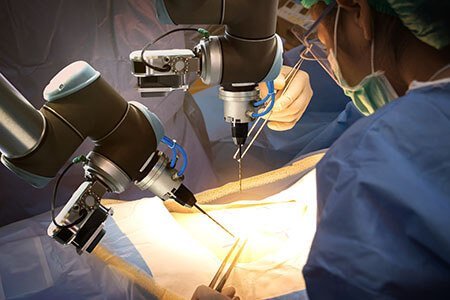


Robotic applications are making inroads into a number of aspects of daily life around the world. In surgery, robotic assistance is helping surgeons tackle a number of complex diseases. Robotic systems are now being used to manage gynaecological problems in women, such as endometriosis and pelvic cancer. Contrary to public perception, the robotic system is not operated by the robot but by a surgeon and a few assistants. The surgeon sits at a machine called the console, where the surgeon looks into a three-dimensional, high-definition camera with images transmitted from a camera placed in the patient’s pelvis. The surgeon’s console has an operator system whereby the movements are reflected on robotic instruments situated within the patient. Robotic surgical assistance has proven to improve patient recovery time as well as reduce blood loss. It has shown success in managing complicated cases, and experts in the field of gynaecological surgery consider it useful, especially in women with endometriosis, wherein the intestine (bowel) is stuck to other organs within a woman’s pelvis. Additionally, the improved dexterity of the robotic instruments help in removing cancer of a woman’s genital organs including lymph nodal spread. Endometriosis is an entity that is seen more often by gynaecologists across India and around the world. It is seen in varying age groups and can involve the ovary, fallopian tubes, and even the bowel. Under rare circumstances, it can involve organs at distant locations. A woman may suffer from pain during her periods, during sexual intercourse, or even problems with the passage of stools if her intestine is involved. Robotic surgery does, however, come with a cost constraint. It requires an elaborate setup and a larger operating room space. It is restricted to large corporate hospitals and also needs multiple assistants, including a special technician for the robot itself. The use of the robot is at the discretion and expert advice of the gynaecological surgeon. Most gynaecological pathologies can be managed with laparoscopic intervention, which has been in practice for years. Laparoscopic surgery is also used for problems such as ovarian cysts, fibroid tumours of the uterus, and hysterectomy, to name a few. Recently, advances in technology have taken place in both laparoscopic and robotic surgery. These have included safer instruments and improved high definition and three dimensional vision which improves surgical outcome. Every year brings with it more and more innovations and improvements in these systems to help surgeons serve patients better. As a patient, it is important to be aware of possible methods to tackle a problem and seek the help of surgeons who are adept at using these methods of keyhole surgery. We must remember that even though technology is advancing every year, it is the surgeon behind the tool that makes the difference.
Dr Gaurav S Desai is an expert who specialises in Gynaecological surgery